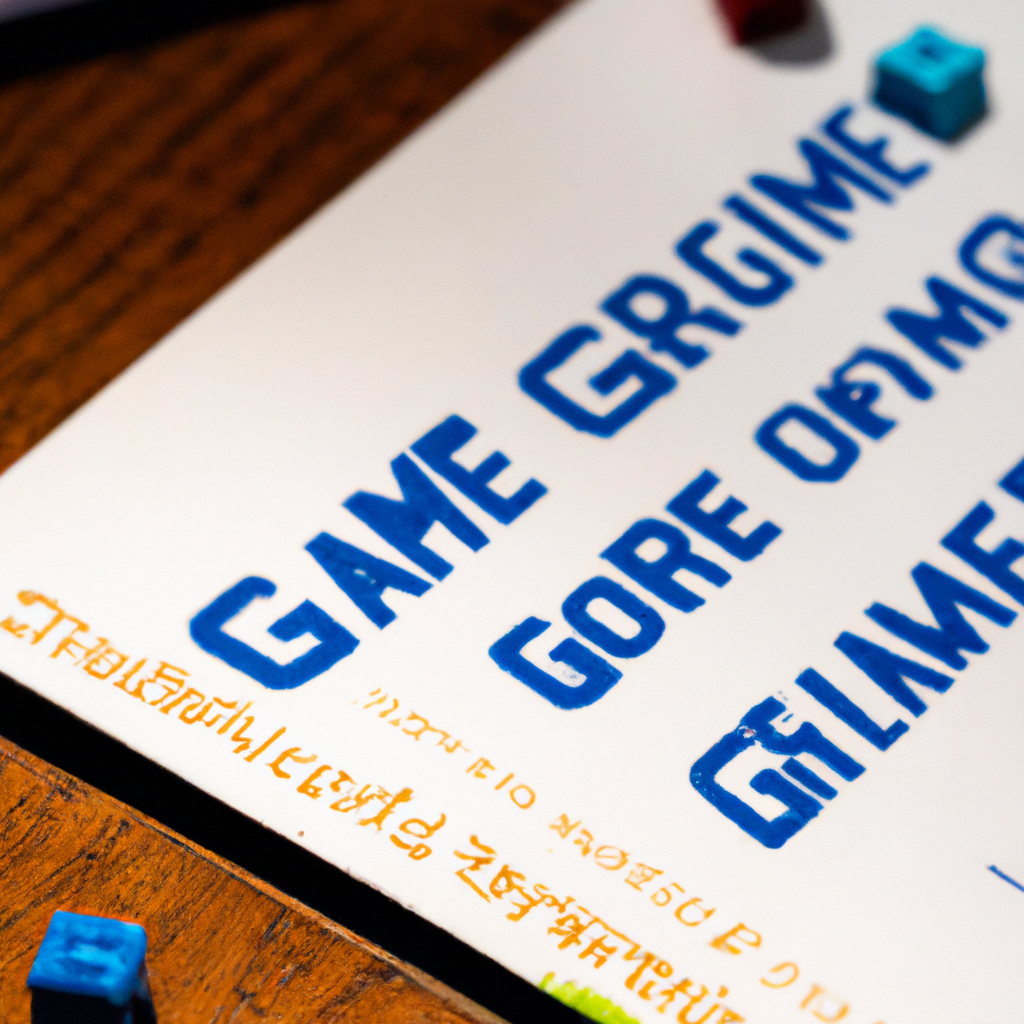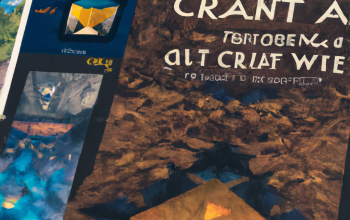Ever dreamed of immersing yourself in fantastical worlds of your own creation? Curating a universe where heroes triumph over evil, puzzles baffle the mind, and challenges ignite our competitive spirits? Game development and design provide an enchanting gateway to transform imaginative ideas into thrilling gameplay experiences. Shedding the cloak of mystery surrounding this captivating realm, we invite you to embark on a journey of learning the basics of game development and design. Whether you’re a budding creator yearning to unleash your ingenuity or a curious enthusiast seeking to unravel the secrets behind your favorite games, this article will equip you with the fundamental knowledge to turn your wildest visions into a living, breathing reality. Jump into this exciting adventure as we reveal the tools, techniques, and skills required to bring your own games to life, while nurturing your creative spirit along the way. Get ready to soar beyond the constraints of mere player and embrace the boundless universe of game development and design. Let’s venture forth and delve into the captivating realm of creating your own games!
Sculpting Virtual Realities: Unleashing Your Creativity with Game Development and Design
Are you ready to embark on an incredible journey into the world of game development and design? Sculpting virtual realities allows you to unleash your creativity like never before, creating immersive experiences that transport players to breathtaking and fantastical worlds. Whether you are an aspiring developer or a seasoned designer looking to upskill, this guide will provide you with the essential tools and techniques to bring your vision to life.
First and foremost, familiarize yourself with the multitude of game development platforms available to you. From Unity to Unreal Engine, each platform offers unique features and capabilities that cater to different game genres and design styles. So, dive in and experiment with these powerful engines, letting your imagination run wild as you blend together stunning visuals, captivating storytelling, and seamless gameplay mechanics.
- Master the art of 3D modeling and animation to bring your virtual worlds to life.
- Learn the fundamentals of programming, enabling you to create interactive gameplay experiences.
- Discover the power of audio engineering, using sound to enhance immersion and captivate players.
- Explore the realm of virtual reality and augmented reality, pushing the boundaries of what is possible within the gaming industry.
Remember, game development is a collaborative process. Surround yourself with fellow enthusiasts and professionals who share your passion. Engage in forums, attend industry conferences, and join game development communities to exchange ideas, seek inspiration, and receive valuable feedback on your work. The journey towards sculpting virtual realities awaits, so pick up your metaphorical chisel and start creating the digital masterpieces of tomorrow!
Building Blocks of Game Creation: Exploring the Fundamentals of Game Development
When it comes to game development, understanding the building blocks that lay the foundation is crucial. These fundamental elements serve as the backbone of every successful game, shaping its mechanics, progression, and overall experience. In this article, we’ll embark on an exciting journey through the intricate world of game creation, exploring the key components that bring virtual worlds to life.
The Power of Storytelling:
One of the essential building blocks of game creation lies in the power of storytelling. Immersive narratives captivate players and drive their engagement. Crafting a compelling storyline that hooks players from the start is a skilled art form. Developers must meticulously design characters, settings, and plot twists that seamlessly blend with gameplay mechanics. From the humble beginnings of text adventures to today’s cinematic experiences, storytelling remains at the heart of game development, connecting players to the virtual realm they inhabit.
Game Mechanics: The Puzzle Pieces:
Game mechanics serve as the puzzle pieces that interlock to create a cohesive and enjoyable experience. Every game has a unique combination of mechanics that shape its gameplay. Whether it’s shooting enemies in a first-person shooter, solving intricate puzzles in an adventure game, or managing resources in a strategy game, these mechanics dictate how players interact with and explore the virtual world. Strong game mechanics take into account factors like balance, progression, skill level, and player agency, ensuring an engaging and rewarding experience for everyone involved.
From Idea to Execution: Essential Steps to Kickstart Your Game Development Journey
Coming up with a game idea: The first step in kickstarting your game development journey is to come up with a unique and captivating game idea. Take inspiration from your favorite games, movies, books, or even real-life experiences. Brainstorm different concepts, characters, settings, and game mechanics that you find interesting. Don’t be afraid to think outside the box and let your imagination run wild. Consider the type of audience you want to target and ensure your idea appeals to them. Remember, a strong and innovative game idea lays the foundation for a successful game.
Research and planning: Once you have a solid game idea, it’s time to dive into research and planning. Conduct market research to understand the current gaming landscape and identify gaps or opportunities in the market. Analyze similar games to learn from their successes and shortcomings. Create a comprehensive game design document that outlines the game’s mechanics, story, levels, characters, and any other key features. This document will act as your roadmap throughout the development process. Break down your game into manageable tasks and set a realistic timeline for each stage. Having a well-researched plan in place will help streamline your development process and keep you focused on your goals.
Mastering the Art of Game Design: Expert Tips and Tricks for Creating Engaging Games
Game Design Essentials: Unlocking the Secrets to Captivating Gameplay
Embarking on the journey to become a master game designer requires a combination of creativity, strategic thinking, and a deep understanding of what makes a game truly engaging. In this section, we will take a deep dive into some expert tips and tricks that will enhance your game design skills and help you create captivating games that keep players coming back for more.
1. Immerse Players in a Rich and Interactive World
One of the key elements of a successful game is creating an immersive environment that transports players into a captivating world. To achieve this, pay attention to:
- Storytelling: Develop a compelling narrative that serves as the backbone of your game.
- Visuals: Invest in high-quality graphics and art that dazzle the players’ eyes.
- Sound Design: Utilize sound effects and music that complement the gameplay and enhance the overall atmosphere.
- Interactivity: Provide opportunities for players to interact with the world and feel like they have a tangible impact on the game.
2. Create Challenging and Rewarding Gameplay Experiences
A key ingredient in keeping players engaged is to strike a delicate balance between challenge and reward. Here are some strategies to achieve that:
- Progressive Difficulty: Gradually increase the difficulty level to ensure players are constantly challenged as they progress through the game.
- Varied Gameplay Mechanics: Incorporate a mix of gameplay mechanics to keep players engaged and provide fresh challenges.
- Reward System: Design a well-balanced reward system to give players a sense of accomplishment and motivate them to continue playing.
- Meaningful Decisions: Introduce meaningful choices that impact gameplay, adding depth and replayability to your game.
Final Thoughts
As we reach the final level of this article, it’s time to put your game face on and embrace the incredible world of game development and design. We hope you’ve found our guide to be an exhilarating adventure, providing you with the necessary tools to embark on your own digital odyssey.
Remember, creating your own games is not just about conquering pixelated challenges; it’s about unlocking your imagination and bringing your wildest dreams to life. Whether you want to transport players to enchanting fantasy realms or challenge their strategic thinking with mind-bending puzzles, the realm of game development is yours to explore.
Take a moment to reflect on the countless legendary titles that have captured the hearts of millions. They all began as dreams in the minds of passionate creators, and now it’s your turn to step into that illustrious circle. The power to craft worlds, characters, and stories is within your grasp, waiting for you to shape it into something extraordinary.
Now, armed with your newfound knowledge of programming languages, game engines, and design principles, it’s time to embark on your journey. Remember, the path may not always be smooth, and obstacles may seek to thwart your progress. But embrace every setback as an opportunity to learn and grow, as no great game was ever built without overcoming countless challenges along the way.
As you embark on this creative expedition, always stay curious and open-minded. The gaming industry evolves at lightning speed, introducing new technologies and trends with each passing day. Embrace the opportunity to constantly learn, adapt, and infuse your own unique style into your creations.
Most importantly, remember to have fun. Game development is a labor of love, one that requires dedication, patience, and a sprinkle of artistic madness. So don’t be afraid to experiment, take risks, and let your imagination run wild – after all, that’s where the most innovative and captivating games are born.
So go forth, intrepid developer, and create the games that will captivate, challenge, and inspire future generations. The digital realm eagerly awaits your arrival, ready to play host to the worlds you dare to envision. Good luck, and may your creativity forever reign supreme in the gaming cosmos!
When it comes to game development, there’s nothing quite like creating your own games. With the right knowledge and tools, you can create a game that is as unique and dynamic as you wish, and it can be a fun and rewarding experience. To help you get started, here are some of the basics of game development and design.
First, decide what type of game you’d like to create. Do you want to create a console game, such as an RPG or driving game? Or do you want to make an online game, such as a shooter or puzzle game? Each type of game has its own design style and requires different skills. Once you’ve settled on the type of game, you can begin gathering the tools and software you need to get started.
The next step is to come up with a good concept and story for your game. This is where you decide the theme, characters, plot, and objectives for your game. You can create a storyline and characters to fit within the bounds of your chosen genre, or develop entirely new themes. You can also decide how the game will play, including what kinds of game mechanics and levels you want.
Once you have a good foundation, you can begin programming the game. This includes creating the game’s code and graphics, as well as making sure the game plays as you envisioned it. Depending on the type of game you’re making, you may require specific programming languages and tools. Learning the basics of programming can be challenging, but there are plenty of resources available to help.
Creating your own game can be a fun and exciting experience that allows you to unleash your inner designer. With the right knowledge and patience, anyone can craft a unique and rewarding gaming experience. By learning the basics of game development and design, you can create a game that is as dynamic and exciting as you want.



